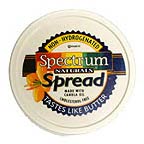Thursday 15 December, 2005, 02:00 - Spectrum Management
 The concept of 'spread spectrum' dates back to World War II when the concept was put to use as countermeasures against jamming; against detection by radar; against detection of navigation beacons and as a way to make interception of communications more difficult. The idea is to take a signal and spread it across a much wider range of frequencies than the originating (data) signal would have otherwise occupied; indeed this is one of the two requirements of a system to be officially designated as spread spectrum. The other requirement is that some function of the original data signal has an impact on the final spread spectrum signal - a technicality that we won't bother with here as it's not relevant to the ensuing discussion.
The concept of 'spread spectrum' dates back to World War II when the concept was put to use as countermeasures against jamming; against detection by radar; against detection of navigation beacons and as a way to make interception of communications more difficult. The idea is to take a signal and spread it across a much wider range of frequencies than the originating (data) signal would have otherwise occupied; indeed this is one of the two requirements of a system to be officially designated as spread spectrum. The other requirement is that some function of the original data signal has an impact on the final spread spectrum signal - a technicality that we won't bother with here as it's not relevant to the ensuing discussion.But what is the point of this? Why occupy more spectrum than is necessary? Isn't this a highly inefficient use of spectrum?
Well spreading a signal has two noticeable effects:
1. It makes the signal much more difficult to detect;
2. It makes the signal much less susceptible to narrow-band interference (such as traditional jamming signals).
Clearly these effects have immediate military connotations and it is no surprise that (as with many other radio techniques) the idea was first put to use in this context, however these effects also have great benefits for other uses too. Let's examine them one by one.
Reduced likelihood of detection
 From a civil perspective, reducing the likelihood that your transmissions will be heard isn't of major concern except perhaps in public telecommunications networks, however the use of encryption is a much more straightforward way of going about making your transmissions private. For 'reduced likelihood of detection' we could alternatively write 'reduced likelihood of causing interference', as if a signal is difficult to detect, it is unlikely to cause interference to another transmission. In fact, all modern cellular phone networks use some kind of spread spectrum technique to try and reduce the interference that a handset communicating with one base-station causes to other base-stations in the network. Also, for technologies such as Wireless LAN and Bluetooth where many users share the same piece of spectrum, using spread spectrum techniques vastly reduces the probability of users causing each other interference.
From a civil perspective, reducing the likelihood that your transmissions will be heard isn't of major concern except perhaps in public telecommunications networks, however the use of encryption is a much more straightforward way of going about making your transmissions private. For 'reduced likelihood of detection' we could alternatively write 'reduced likelihood of causing interference', as if a signal is difficult to detect, it is unlikely to cause interference to another transmission. In fact, all modern cellular phone networks use some kind of spread spectrum technique to try and reduce the interference that a handset communicating with one base-station causes to other base-stations in the network. Also, for technologies such as Wireless LAN and Bluetooth where many users share the same piece of spectrum, using spread spectrum techniques vastly reduces the probability of users causing each other interference.Of course spread spectrum is not the panacea of interference mitigation as if two spread spectrum signals of the same type and on the same frequency clash they still cause each other interference, but it can go a long way to reducing interference between users, especially in de-regulated radio environments where it's 'every user for themselves'.
Reduced suscepitibility to narrow-band interference
Spreading a signal across a wide-range of frequencies means that the amount of information transmitted in any portion of those frequencies is only a fraction of the overall information being transmitted. As such, if a portion of the spread signal is interfered with, the received data will only be fractionally affected and with data correction techniques it is possible to stop narrow-band signals from interfering with spread spectrum signals at all. Of course one spread spectrum signal could easily interfere with another using the same frequencies as if all the frequencies in use are affected there is generally no way to 'tune-out' the interfering signal.
Spread spectrum systems are therefore largely immune to narrow-band interference such as might be caused by traditional AM or FM signals. As well as the obvious anti-jamming military uses, this still has great benefit in a civil situation where a system has to share spectrum with lots of potentially interfering sources.
Spread Spectrum Techniques
There are two commonly deployed spread-spectrum techniques plus two uncommon ones:
 Frequency Hopping Spread Spectrum (FHSS) is a commonly deployed technique whereby a signal changes frequency or 'hops' (usually very rapidly) across a wide band of available frequencies. The receiver has to be synchronised with the transmitter so that it knows what hopping pattern to follow. If a few of the frequencies onto which the system hops have interference, the overall transmission will still be received as communication continues takes places on the clear frequencies (indeed some systems are intelligent and cease to use frequencies on which interference is present).
Frequency Hopping Spread Spectrum (FHSS) is a commonly deployed technique whereby a signal changes frequency or 'hops' (usually very rapidly) across a wide band of available frequencies. The receiver has to be synchronised with the transmitter so that it knows what hopping pattern to follow. If a few of the frequencies onto which the system hops have interference, the overall transmission will still be received as communication continues takes places on the clear frequencies (indeed some systems are intelligent and cease to use frequencies on which interference is present). Hopping across a wide range of frequencies has one additional benefit: the propagation conditions on one frequency will be different to those on another frequency, such that, especially in mobile environments, FHSS signals provide a way to mitigate against the frequency selective fading that occurs. Even changes in frequency of a few percent can be useful and this is one of the main reasons that GSM networks often employ FHSS from the handsets. Bluetooth also uses FHSS but in this case to dodge between the large number of interfering signal that appear in the shared frequency band it inhabits.
Direct Sequence Spread Spectrum (DSSS) is a commonly deployed technique whereby a radio signal is spread by mixing it with a high bit-rate data spreading signal. At the receiver, the same spreading signal can be used to 'de-spread' the received signal and return it to its original state. This de-spreading results in any narrow-band interference being spread and effectively turned into background noise. Equally, the effect of frequency selective fading (as found in mobile environments) is to null out reception on some frequencies. with DSSS these nulls will be spread to appear as 'anti-noise', or in other words, a small reduction in the overall reveived signal.
Unlike FHSS signals which only occupy one frequency at once, DSSS signals occupy all the frequencies over which they have been spread at the same time. CDMA systems use DSSS, as do Wireless LAN's conforming to many of the 802.11 series of standards.
Chirp is an uncommon technique in which a transmission begins on one frequency and ends on another, changing from one to the other during the period of the transmission. It is difficult to receive such signals as almost perfect synchronisation is needed between receiver and transmitter in terms of time and frequency, however with modern signal processing techniques it is becoming possible.
Chirp, however, is often used for radar systems as it is a spectrally efficient way of generating the wide-bandwidth transmissions that are required to ensure the accuracy of the radar.
Time Hopping Spread Spectrum (THSS) is an undeveloped technique in which, the transmitted signal is turned on and off in a psuedo-random fashion (thus hopping on and off with time). Interest has been raised in this technique as a method for sharing spectrum for Ultra Wide Band devices.
Spread spectrum techniques are now a part of every-day radio usage both for military and civil systems and are allowing more effective use of spectrum to be made as well as providing a means of using otherwise difficult to use spectrum (such as that shared with microwave ovens). What will be the next military technique to make the cross-over to every-day civil usage?
add comment
( 1485 views )
| permalink
| 



 ( 3 / 15866 )
( 3 / 15866 )




 ( 3 / 15866 )
( 3 / 15866 )

